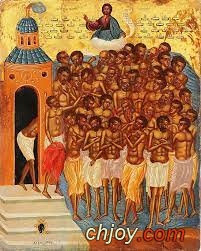
 |
 |
 |
 |
|
رقم المشاركة : ( 1 )
|
|||||||||||
|
|||||||||||
|
Forty Martyrs of Sebaste  It was a bitter cold winter day with fierce winds raging from the north more than 1600 years ago in Sebaste, Lesser Armenia (present-day Sivas, Turkey) when 40 young Roman soldiers froze to death because of their belief in Christ. These brave soldiers openly professed their faith and were ordered to die because they disobeyed an edict issued by the Eastern Roman Emperor Licinius in the year 320. Licinius ordered all soldiers in the Army to worship pagan gods under the threat of torture or death. The 40 young men, coming from diverse nationalities, were know as the XIIth Thundering or “Lightning” Legion. They were widely known throughout the Christian world. Through the intervention of a miraculous thunderstorm the Legion saved the Roman Army at a crucial moment and thus earned the name, the “Lightning” Legion. They were committed to the service of Christ and were also loyal members of the Army. Upon learning of the edict, the members of the Legion appeared before Agrocola, the local governor and proclaimed their faith. Agrocola used promises and threats in an unsuccessful attempt to get them to renounce their belief. They were steadfast in the Faith and said they were prepared to die for Christ. Furious that he could not convince the soldiers to abandon their belief, Agrocola devised a novel torture. Capitalizing on the cold weather he ordered the men to be exposed naked on a frozen lake. He thought this slow death by freezing would allow them the opportunity to apostatize. To entice them into recanting, a warm bath was set up on shore. Aware that their death was imminent they wrote their last thoughts in “The Testament of the Forty Holy Martyrs of Christ.” In it they appealed to their families not to grieve excessively and to fulfill their wish that their remains be disposed of in a manner so they could all remain together in death. The martyrs also wrote of their concern for the youngest member of their group. Because of his age, they hoped their persecutors might show him clemency. They prayed that if he was spared he would remain faithful throughout his life to the law of Christ. If not, they prayed that he would bear up under his trial with them to the end. There is a special plea from one of the martyrs warning the younger members of his family to be on guard against the passing pleasures of the world. He urges them to follow the teachings of Christ. As the martyrs undressed, they prayed “Lord, to the number of 40 have we entered the arena, grant to all the crown. May no unit be lacking to the number which Thou hast chosen for a specific purpose.” Out of the 40 soldiers, one succumbed to weakness. He renounced his faith and as he left the group for the warm bath on shore he died. The remaining 39 prayed aloud for courage. One of the pagan guards seemed to see a band of angels descend and place crowns of victory on their heads. He was so overcome by this spectacle that he stripped and rushed to die at their side. The following morning, detecting life in many of the soldiers, the guards broke their legs and threw the bodies into the fire. Their ashes were thrown into the lake. It is said that for nights after the incident, a heavenly light shone over the water where the brave soldiers perished. Devotion to the Forty Martyrs soon spread throughout the world. In St. Basil’s city of Caesarea in Cappadocia (Turkey) a basilica was built in their honor. It is believed that St. Gaudentius introduced their cult and relics to the West. A chapel dedicated to them was discovered in 1901 in the Church of Santa Maria Antiqua in Rome with a representation dating from the sixth or seventh century depicting their martyrdom. Santa Maria Antiqua is at the foot of the Palatine Hill in the Roman Forum. One of the frescoes in the chapel shows, of all things, a clothed Christ on the cross. The Eastern churches celebrate the Feast of the Forty Martyrs of Sebaste on March 9 with these words: “Leaving all soldiery of the world you, the forty trialbearers of the Lord, have cleaved to the Heavenly Master; for, passing through fire and water, O blessed ones, you have justly received glory from heaven and a multitude of crowns. |
 |
| أدوات الموضوع | |
| انواع عرض الموضوع | |
|
| قد تكون مهتم بالمواضيع التالية ايضاً |
| الموضوع |
| The Lord Jesus Christ fasted for forty days and finally became hungry |
| What about the forty days which the Lord |
| The 21 martyrs in Libya |
| martyrs de Damas |
| Continuation. Several other martyrs. |